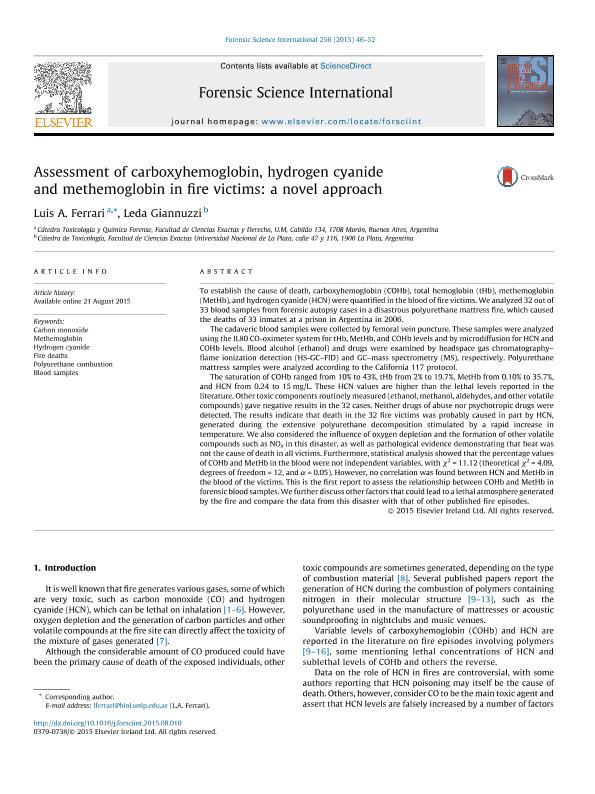Artículo
Assessment of carboxyhemoglobin, hydrogen cyanide and methemoglobin in fire victims: A novel approach
Fecha de publicación:
11/2015
Editorial:
Elsevier Ireland
Revista:
Forensic Science International
ISSN:
0379-0738
Idioma:
Inglés
Tipo de recurso:
Artículo publicado
Clasificación temática:
Resumen
To establish the cause of death, carboxyhemoglobin (COHb), total hemoglobin (tHb), methemoglobin (MetHb), and hydrogen cyanide (HCN) were quantified in the blood of fire victims. We analyzed 32 out of 33 blood samples from forensic autopsy cases in a disastrous polyurethane mattress fire, which caused the deaths of 33 inmates at a prison in Argentina in 2006. The cadaveric blood samples were collected by femoral vein puncture. These samples were analyzed using the IL80 CO-oximeter system for tHb, MetHb, and COHb levels and by microdiffusion for HCN and COHb levels. Blood alcohol (ethanol) and drugs were examined by headspace gas chromatography-flame ionization detection (HS-GC-FID) and GC-mass spectrometry (MS), respectively. Polyurethane mattress samples were analyzed according to the California 117 protocol. The saturation of COHb ranged from 10% to 43%, tHb from 2% to 19.7%, MetHb from 0.10% to 35.7%, and HCN from 0.24 to 15mg/L. These HCN values are higher than the lethal levels reported in the literature. Other toxic components routinely measured (ethanol, methanol, aldehydes, and other volatile compounds) gave negative results in the 32 cases. Neither drugs of abuse nor psychotropic drugs were detected. The results indicate that death in the 32 fire victims was probably caused in part by HCN, generated during the extensive polyurethane decomposition stimulated by a rapid increase in temperature. We also considered the influence of oxygen depletion and the formation of other volatile compounds such as NOx in this disaster, as well as pathological evidence demonstrating that heat was not the cause of death in all victims. Furthermore, statistical analysis showed that the percentage values of COHb and MetHb in the blood were not independent variables, with χ2=11.12 (theoretical χ2=4.09, degrees of freedom=12, and α=0.05). However, no correlation was found between HCN and MetHb in the blood of the victims. This is the first report to assess the relationship between COHb and MetHb in forensic blood samples. We further discuss other factors that could lead to a lethal atmosphere generated by the fire and compare the data from this disaster with that of other published fire episodes.
Archivos asociados
Licencia
Identificadores
Colecciones
Articulos(CIDCA)
Articulos de CENTRO DE INV EN CRIOTECNOLOGIA DE ALIMENTOS (I)
Articulos de CENTRO DE INV EN CRIOTECNOLOGIA DE ALIMENTOS (I)
Citación
Ferrari, Luis A.; Giannuzzi, Leda; Assessment of carboxyhemoglobin, hydrogen cyanide and methemoglobin in fire victims: A novel approach; Elsevier Ireland; Forensic Science International; 256; 11-2015; 46-52
Compartir
Altmétricas




